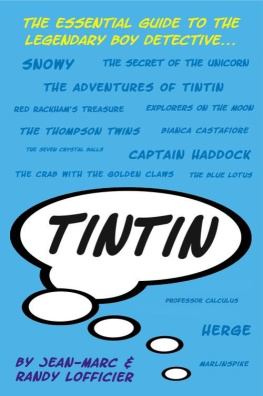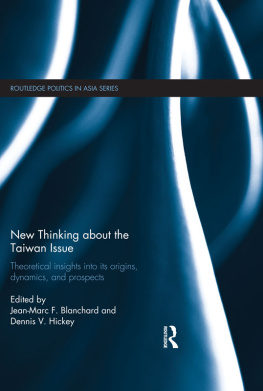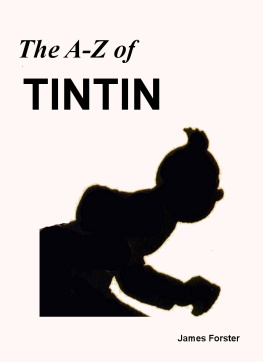Lofficier Jean-Marc - Tintin
Here you can read online Lofficier Jean-Marc - Tintin full text of the book (entire story) in english for free. Download pdf and epub, get meaning, cover and reviews about this ebook. City: Harpenden, year: 2011, publisher: Oldcastle Books;Pocket Essentials, genre: Detective and thriller. Description of the work, (preface) as well as reviews are available. Best literature library LitArk.com created for fans of good reading and offers a wide selection of genres:
Romance novel
Science fiction
Adventure
Detective
Science
History
Home and family
Prose
Art
Politics
Computer
Non-fiction
Religion
Business
Children
Humor
Choose a favorite category and find really read worthwhile books. Enjoy immersion in the world of imagination, feel the emotions of the characters or learn something new for yourself, make an fascinating discovery.
- Book:Tintin
- Author:
- Publisher:Oldcastle Books;Pocket Essentials
- Genre:
- Year:2011
- City:Harpenden
- Rating:3 / 5
- Favourites:Add to favourites
- Your mark:
- 60
- 1
- 2
- 3
- 4
- 5
Tintin: summary, description and annotation
We offer to read an annotation, description, summary or preface (depends on what the author of the book "Tintin" wrote himself). If you haven't found the necessary information about the book — write in the comments, we will try to find it.
Tintin — read online for free the complete book (whole text) full work
Below is the text of the book, divided by pages. System saving the place of the last page read, allows you to conveniently read the book "Tintin" online for free, without having to search again every time where you left off. Put a bookmark, and you can go to the page where you finished reading at any time.
Font size:
Interval:
Bookmark:
The silhouette of Tintin - a young man wearing golf trousers, running with a white fox terrier by his side - is easily one of the most recognisable visual icons of the modern world. In fact Tintin is nine years older than Superman and ten years older than Batman, having first appeared in Belgium in 1929.
In this fully revised and expanded edition of this popular pocket-sized reference book the authors offer a comprehensive and critical overview of the Tintin series.
Starting with the characters humble origins in the childrens supplement of a Belgian catholic newspaper in the 1920s, the authors track Tintins development and success throughout the decades, including the stormy World War II years.
Each book is analyzed in detail, both in the context of the series, and in its larger framework: that of the comics medium and of society in general. The authors also look at the massive industry that has developed round the figure of Tintin, the trivia, the anecdotes, the movies, and television series, and the multitude of Tintin spin-offs.
Jean-Marc and Randy Lofficier have written and edited comic books for fifteen years, including Dr. Strange, Clive Barkers Hellraiser, Teen Titans, SuperMans Metropolis, Tongue*Lash, Batman: Nosferatu and Tales of the Shadowmen. They received the 1990 Inkpot Award for Outstanding Achievement in Comic Arts. They are the authors of numerous non-fiction books about science fiction and fantasy such as The Doctor Who Programme Guide, Into the Twilight Zone and French Science Fiction, Fantasy, Horror and Pulp Fiction. They have also written animation scripts for television series such as The Real Ghostbusters and Duck Tale.
With thanks to
Ivan Noerdinger, Benot Peeters, Philippe Goddin
Twentieth-century
In the end, you know, my only international rival is Tintin! Were both little guys who dont let the big guys walk all over them. You dont see it because of my height.
Charles de Gaulle (18901970)
The silhouette of Tintin a young man wearing golf pants running with a white fox terrier by his side is easily one of the most recognisable visual icons of the modern world, as much as Mickey Mouses ears or Snoopy playing World War One ace on his doghouse.
Tintin was born or made his first public appearance in Belgium on 10 January 1929. Some sociologists argue that the twentieth century really began only after World War One, and that would indeed make Tintin a child of the last century. His putative birth occurred mere months before the Great Depression, and a decade before World War Two, two of the twentiethth centurys defining events.
To put this into the context of comics history, Tintin was created the same year that American cartoonist Elzie Segar created the spinach-chewing Popeye, and artist Dick Calkins drew the adventures of Buck Rogers, adapted by Phil Nowlan from his own science fiction story. The notion that Tintin is, in fact, nine years older than Superman and ten years older than Batman usually causes mild cultural shock on both sides of the Atlantic, even among the most educated comics fans, who somehow regard the character as timeless.
It is that very timelessness that makes Tintin the perfect symbol of the twentieth century, a true witness to our era, spotlighting with astonishing 20/20 clarity all the high points of our recent history: Tintin was a Western European coloniser in Africa in the 1930s; he battled bootleggers in Chicago during Prohibition and fought alongside the Chinese against the Japanese; he walked on the moon; and in the 1970s he sided with South American guerrillas. Tintin always fitted in; anywhere, anywhen. And more so, he always made us aware that there were two sides to every story and did it with a smile.
When we read Tintin, we simultaneously hold two images in our minds: the image we see and Hergs amazingly symbolic vision. Apollo XII and Professor Calculus red & white chequered rocket become inseparable from each other in our collective photo album. The story of Tintin is the story of our times.
When symbols pass away, the outpouring of grief is out of proportion with the actual event, because people do not mourn the person who died but the part of themselves that is floating away on the river of time. On 3 May 1983, when Tintins creator, Herg, passed away at age 76, for many it was Tintin who died that day. It symbolised to all who had shared in the young reporters adventures that a portion of their lives had suddenly come to an end.
The leading French and Belgian newspapers devoted their front pages to the news, illustrating it with the by-then famous panel culled from Tintin In Tibet showing Tintin shedding a tear over the seeming death of his friend Tchang, or the one where Snowy stands over his masters unconscious body. Tintin mourned his father; fans mourned Herg.
Never had the passing of a cartoonist other than perhaps that of Walt Disney generated as much public grief and news stories, a vibrant testimony to the deep and everlasting importance of Tintin in French-speaking culture.
When one first looks at Tintin , there may be a tendency to dismiss it as being simplistic. It is, after all, supposed to be a story for children. But as one begins reading, the clarity and expressiveness of the design is revealed, almost like a blurred image slowly coming into focus. Very few artists ever had Hergs ability to blend coherent storytelling, depth of characterisation and outstanding expression of emotion in such a fashion.
Contemporary comics scholars like to point at the progress made by comics in becoming more adult (whatever that means) in the recent past by rightly singling out the works of writers such as Alan Moore, Neil Gaiman or Los Brothers Hernandez. But in fact, the Tintin comics were the first to have gone adult. As early as 1934, encouraged by his friend, Chinese student Tchang Tchong-Jen, Herg had plunged his hero into the midst of the Japanese invasion of China. The publication of The Blue Lotus in the pages of a Belgian newspaper provoked the ire of Japanese officials and several personalities protested the alleged harm done by Herg to Nippo-Belgian relations. Conversely, the artist was invited to China by Tchang Kai-Cheks wife. No comic since then has ever provoked so much interest or controversy from the adult world, or has been treated as seriously as The Blue Lotus was in 1934.
And no comics writer or artist has been called before a tribunal to explain and justify his work, as Herg was after the war, when the authorities of a newly-liberated Belgium questioned his book The Shooting Star. Drawn in Nazi-occupied Belgium for a Nazi-sympathetic newspaper, the book happened to give all the good roles to the pro-Axis and neutral states, while making America into a villain.
For good and bad, Herg blazed a trail his comics were not only adult, they were the product of adult choices, reflected adult concerns, were read by adults and ultimately judged by adults. Can that be said about any other comic works or creators?
Artistically, Tintin was the first comic ever to offer its reader a fully self-contained, totally coherent fantasy universe. Long before the intricate universes of Marvel Comics and its rivals, Herg had built a rich and complex world centred around a simple hero, a teenage reporter not unlike Clark Kent flanked by his faithful pet and which included a gallery of wonderful supporting characters. The humanity of Haddock, the eccentricities of Calculus, the goofiness of the Thompsons, the mercurial nature of the Castafiore and the obnoxiousness of Jolyon Wagg become more familiar to us than the antics of our own relatives. The Tintin Family forms a Human Comedy that rivals that of Balzac.
Font size:
Interval:
Bookmark:
Similar books «Tintin»
Look at similar books to Tintin. We have selected literature similar in name and meaning in the hope of providing readers with more options to find new, interesting, not yet read works.
Discussion, reviews of the book Tintin and just readers' own opinions. Leave your comments, write what you think about the work, its meaning or the main characters. Specify what exactly you liked and what you didn't like, and why you think so.








